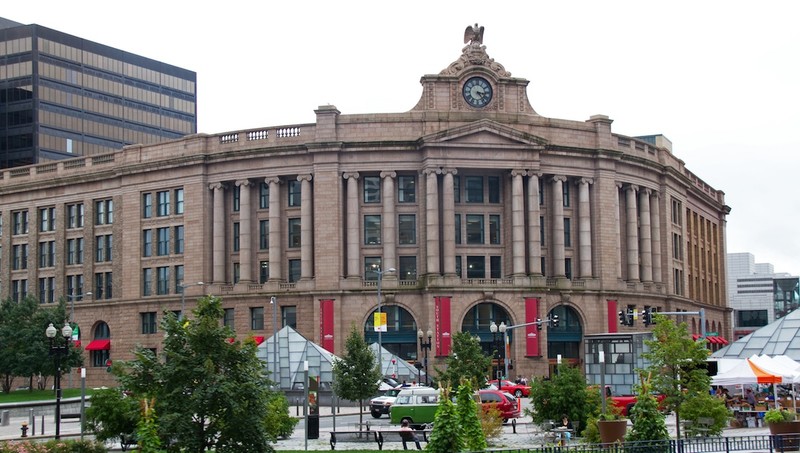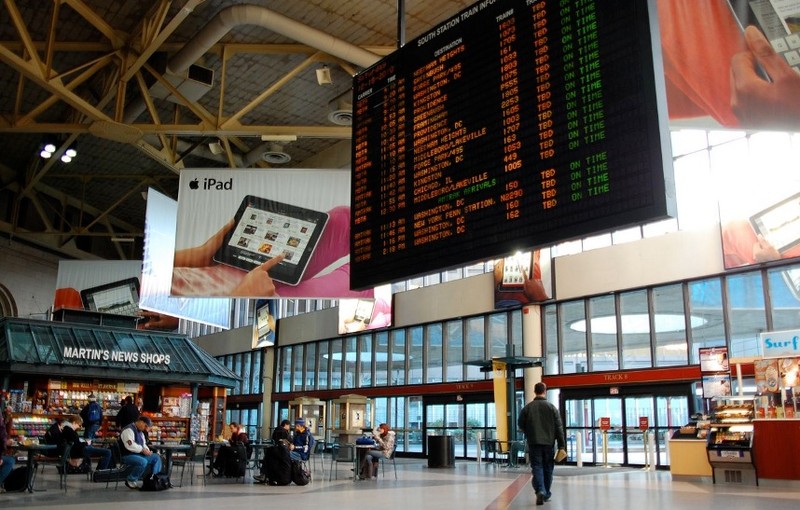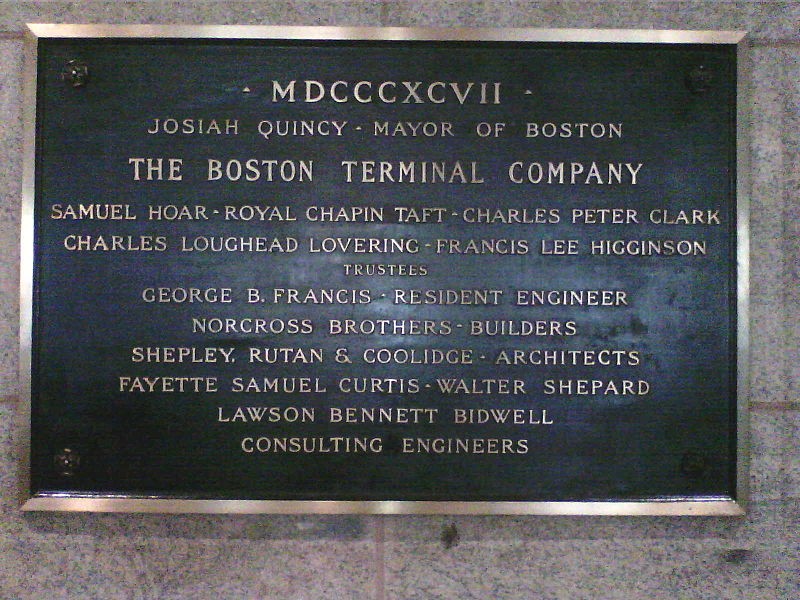South Station
Introduction
Text-to-speech Audio
Images
South Station,

Inside the South Station Terminal

Plaque inside the South Station Terminal

Backstory and Context
Text-to-speech Audio
In the latter half of the nineteenth century, there were five separate rail lines running into Boston’s south side: the Boston and Albany Railroad Company; the New England Railroad Company; the Boston and Providence Railroad Corporation; the Old Colony Railroad Company; and the New York, New Haven and Hartford Railroad Company. These five rail companies merged to form the Boston Terminal Company. The Boston Terminal Company was awarded a charter by the Massachusetts Legislature in 1876 to service travelers in the Boston area.
Between 1896 and 1899, the company sold public bonds, purchased a 35-acre site near the Fort Point Channel, and built the colossal structure known as South Station. They paid $9 million for the land. The City of Boston provided $2 million in funds towards some infrastructure development in the area, particularly to reroute streets and utilities as well as to build a 200-foot granite seawall along Fort Point Channel. The wall was intended to protect the rail station since it was so close to the harbor.
The massive building constructed on the property was designed by the architectural firm of Shepley, Rutan and Coolidge. It is a five-story Neoclassical Revival-Style. The original structure was developed with a plan to hold 613 rail cars at one time. Visitors standing in front of the building will notice two outstanding pieces of the building’s architecture. First, over the three grand archways leading into the station, there is a large clock situated on top of the structure. This the original clock, made locally by the E. Howard Clock Company of Roxbury, Massachusetts. The clock serves two functions. The first, and most obvious, service provided by the clock is to tell Bostonians the correct time. However, the clock is also symbolic. It is still wound by hand and symbolizes the railroad’s time-honored tradition of punctuality and speed. The mechanism that powers the clock is the same that operates in London’s Big Ben.
The second feature that adorns the building stands directly above the clock. There is an 8-foot tall statue of an eagle which weighs 160,000 pounds, made entirely of granite. The eagle sits perched on top of the clock, watching travelers coming in and out of the station.
Construction was completed by the end of 1898. On New Year’s Eve, a dedication ceremony was held which included speeches by the Mayor of Boston (Josiah Quincy) and the Boston Terminal Company’s president. The first train was put into service early the next morning. It departed for Newport, Rhode Island at 4:38 A.M., filled with 12 tons of Boston-based newspapers.
The new train station was soon the busiest in the nation, boasting that it served over 36 million passengers each year. However, its busiest year occurred at the end of World War II. In 1945, an estimated 46 million people traveled through South Station - an average of 125, 000 each day. After the war, rail travel began to decline when people started using air and automobile transportation more often. The large railroad companies failed and several declared bankruptcies. New highways were being constructed instead of fixing the deteriorating rail systems. By the mid-1960s, the passenger count through South Station dropped from a high of 46 million people in 1945 to a mere 4.5 million. Boston commenced destruction of several of the old platforms and the east wing of the terminal. In 1965, the Boston Redevelopment Authority purchased the real estate for $6.95 million – far below the costs paid when the station was constructed 70 years earlier. The plan was to raze the standing structure in order to build a new facility with modern features. Some of the demolition happened before the project could be stopped. A group was established during the 1970s to save what remained of the old South Station, which included the headhouse and the grand waiting room. Due to their efforts, South Station was added to the National Register of Historic Places in 1975.
Three years later, the Boston Redevelopment Authority sold the station to the Massachusetts Bay Transportation Authority (MBTA) for 6.1 million dollars. The MBTA, with funds from a variety of agencies and private corporation, began a $195 million restoration project at South Station. The renovation included plans to reconstruct part of the headhouse and 11 station tracks (which would now include high level platforms) and the new construction of a bus terminal and a parking garage. By 1989, the renovations were completed and South Station continues to operate as the busiest transit hub in New England.
Cite This Entry
Ritz, Erin and Clio Admin. "South Station." Clio: Your Guide to History. March 5, 2017. Accessed July 25, 2025. https://theclio.com/entry/32962
Sources
South Station Train Terminal: A Building With History. South Station Boston. Accessed March 04, 2017. http://www.south-station.net/station-history/.
South Station Facts for the architecture enthusiast, or the simply curious. South Station Boston. Accessed March 04, 2017. http://www.south-station.net/did-you-know/.

